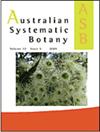标题新西兰Siphonolejeunea属的订正界称及一新种
IF 1.6
3区 生物学
Q4 EVOLUTIONARY BIOLOGY
引用次数: 3
摘要
摘要利用已发表的nrITS、rbcL和trnL-F序列数据对Nephelolejeunea的单系性进行了分子系统发育研究,结果表明Nephelolejeunea与Siphonolejeunea具有副系性。因此,Nephelolejeunea和Siphonolejeunea被合并,由于后者的名称具有优先权,在Siphonolejeunea中形成了10个物种的新组合。对该名称的有效发表进行了重新评价,我们得出结论,Siphonolejeunea亚属和Siphonolejeunea olgae都是在1963年有效发表的。本文根据新西兰Wairarapa的一份标本报道了新发现的Siphonolejeunea bidentata,根据最近在Te Paki的一份标本描述了一个新种Siphonolejeunea raharahanehemiae,该新种生长在Metrosideros bartlettii(桃科)的枝条上,我们提供了一个修订的Siphonolejeunea种的检索表。与Cololejeunea angustiflora关系相关的nrITS和叶绿体标记之间的信号显著冲突,叶绿体序列数据表明可能与其他Cololejeunea不属于一类,这是系统发育中另一个有趣的结果。该植物及其亲缘关系值得进一步研究。本文章由计算机程序翻译,如有差异,请以英文原文为准。
A revised circumscription for Siphonolejeunea and a new species from New Zealand
Abstract. A molecular phylogeny to test the monophyly of Nephelolejeunea by using previously published nrITS, rbcL and trnL–F sequence data demonstrated that Nephelolejeunea is paraphyletic with respect to Siphonolejeunea. Nephelolejeunea and Siphonolejeunea are, therefore, merged and, as the latter name has priority, new combinations in Siphonolejeunea are made for 10 species. The valid publication of the name Austrolejeunea is re-evaluated and we conclude that both Siphonolejeunea subgenus Austrolejeunea and Siphonolejeunea olgae were validly published in 1963. Siphonolejeunea bidentata is reported as new for New Zealand on the basis of a collection from the Wairarapa, a new species, Siphonolejeunea raharahanehemiae, is described on the basis of recent collections from Te Paki, where it grows on the twigs of Metrosideros bartlettii (Myrtaceae), and we provide a revised key to species of Siphonolejeunea. The significant conflict in signal between nrITS and chloroplast markers associated with the relationships of Cololejeunea angustiflora, which chloroplast sequence data suggest may not be grouped with the rest of Cololejeunea, is another interesting result from the phylogeny. The relationships of Cololejeunea angustiflora and its allies warrant further investigation.
求助全文
通过发布文献求助,成功后即可免费获取论文全文。
去求助
来源期刊

Australian Systematic Botany
生物-进化生物学
CiteScore
3.10
自引率
12.50%
发文量
12
审稿时长
>12 weeks
期刊介绍:
Australian Systematic Botany is an international journal devoted to the systematics, taxonomy, and related aspects of biogeography and evolution of all algae, fungi and plants, including fossils. Descriptive taxonomic papers should normally constitute a comprehensive treatment of a group. Short papers on individual species and nomenclatural papers must contain significant new information of broader interest to be considered. The prestigious L.A.S. Johnson Review Series is published. Other review articles will also be considered. All papers are peer reviewed.
Australian Systematic Botany is published with the endorsement of the Commonwealth Scientific and Industrial Research Organisation (CSIRO) and the Australian Academy of Science.
 求助内容:
求助内容: 应助结果提醒方式:
应助结果提醒方式:


